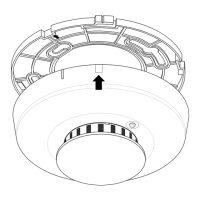
Do you have a question about the Interlogix 511C and is the answer not in the manual?
| Power Source | 120VAC with 9V Battery Backup |
|---|---|
| Type | Photoelectric |
| Operating Voltage | 120VAC |
| Operating Temperature | 40°F to 100°F |
| Operating Humidity | 10% to 95% relative humidity (non-condensing) |
| Alarm Sound Level | 85dB at 10 feet |
| Interconnect Capability | Up to 12 units |
| Hush Feature | Yes |
| LED Indicator | Yes |
| Compliance | UL 217 |
Discourages unauthorized removal using a screwdriver to detach the detector from its base.
Notifies the control panel when the optical chamber needs replacement, available on 521/528 Series.
Performs daily and on-power-up diagnostic tests, meeting NFPA 72 field sensitivity testing needs.
Automatically adjusts sensitivity up to 1.0%/ft to compensate for detector dirt accumulation.
Uses ESL 505 module to convert 2-wire detectors to a 4-wire input for panels without 2-wire capability.
DIP switch allows installer to select between 12/24V or 6/12V operation for 2-wire models.
Locate between sleeping areas and the rest of the unit for optimal early warning against fire threats.
Requires detectors as in existing construction, plus an additional detector in each bedroom.
Suggests extra detectors for areas not covered by code for increased protection and early warning.
Avoid bathrooms, kitchens, and ventilation sources; maintain distance from walls and ceilings.
Remove knockout and break tab on mounting base if utilizing the detector/base lock feature.
Run system wiring to location, mount electrical boxes, attach gasket and base, and connect wires.
Align the raised tab on the detector with the arrow on the base, insert, and turn clockwise 15 degrees.
Use a test magnet on the detector's TEST letters and observe LED flashes to determine sensitivity.
Table details flash counts for unserviceable faults, low sensitivity, normal range, and high sensitivity.
Clean exterior with damp cloth; replace optical chamber by removing cap, discarding old chamber, and installing new.
Detectors require minimal maintenance and should be tested monthly for proper function.
Emphasizes avoiding fire hazards and preparing an escape plan, including drills and meeting points.
Highlights that detectors are not substitutes for life insurance and have limitations in detecting all fires.
Details electrical ratings, operating conditions, sensitivity, dimensions, and certifications for various models.
Lists available models by part number, description (e.g., 2-wire, 4-wire, heat sensor), and voltage.
Lists compatible accessories such as CleanMe modules, test magnets, canned smoke, and replacement chambers.
